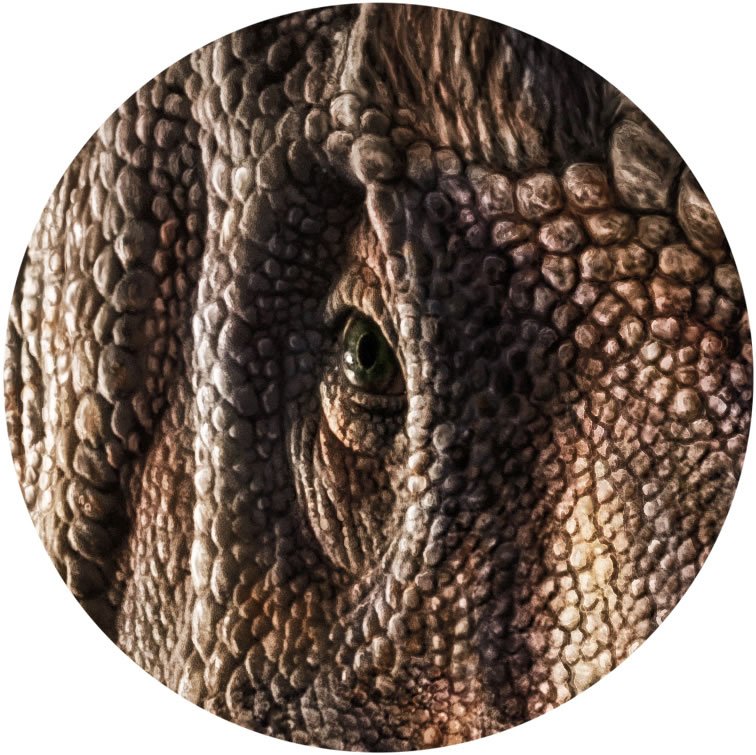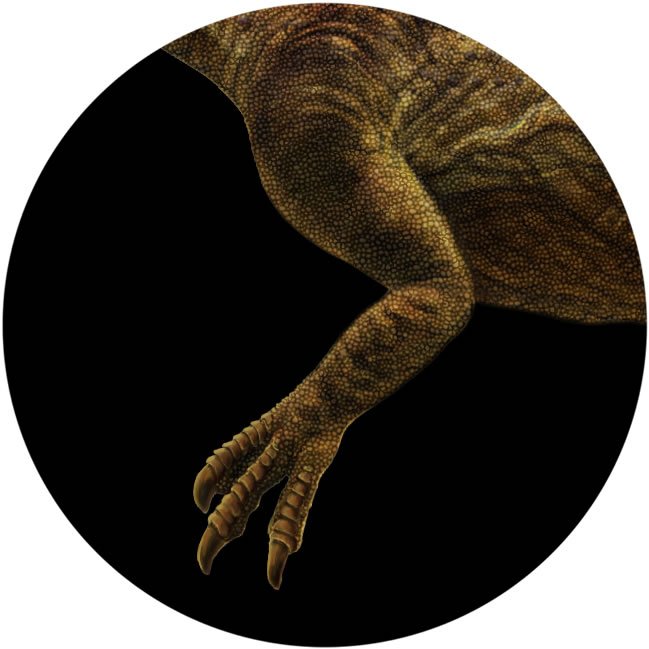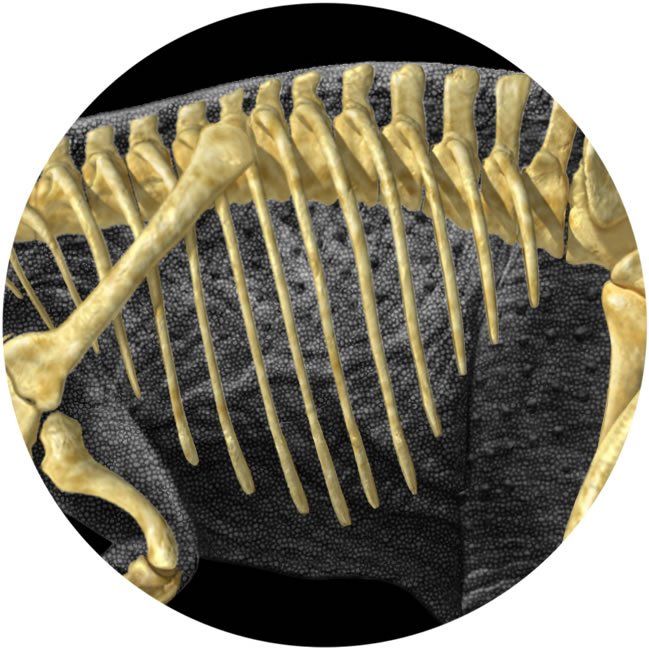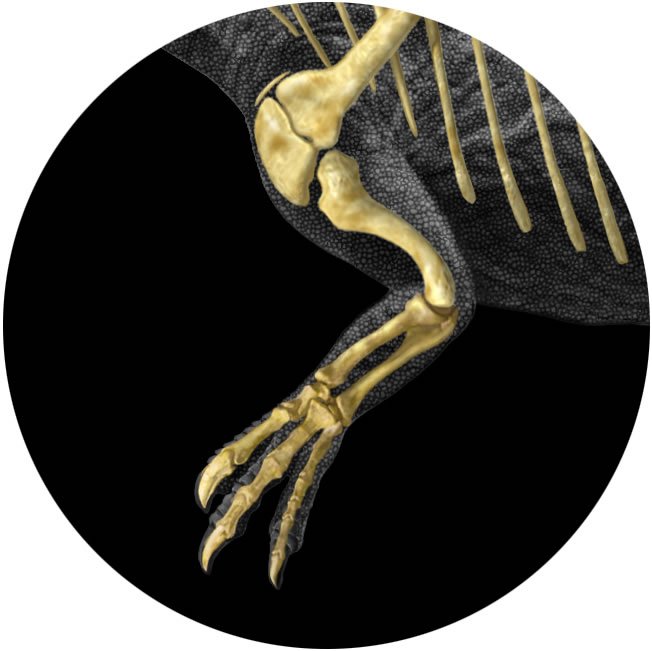
Allosaurus—A Creationist’s Best Friend
For decades, dinosaurs have troubled Christians who didn’t know how to explain them from the Bible. Even the secular media assume dinosaurs are an enigma to believers. That explains why they were baffled when a creationist museum put a full-size Allosaurus on display.
News Flash:
A world-class dinosaur fossil—a 30-foot long, meat-eating Allosaurus—takes center stage at a creationist museum. This announcement last April dumbfounded evolutionists.
“If you are a creationist—if you believe that God created the world in six days, the Bible is a literal history—then fossils are an awkward thing for you,” commented Rachel Maddow on MSNBC. After all, “Fossils are the physical record of living things that died millions of years ago.”
Her comments were typical of media reactions. “Humans and dinosaurs together?” she scoffed, and then said that the belief belongs to “the paranoid fringe.”
Sadly, most Christians don’t even know the truth about dinosaurs. Each year Liberty University, for example, surveys its online students before they take the creation course “The History of Life.” Although many of these students grew up in conservative churches and affirm that the Bible is infallible and Adam was real, when asked if “dinosaurs and man lived at the same time,” fewer than half strongly agree at the beginning of the course (but that number rises to 85% by the end of the term!).
In a world saturated with claims that dinosaurs prove the earth is millions of years old, Christians need ready answers at their fingertips. Properly understood, dinosaurs aren’t “awkward” but our best friends—powerful evidence that Genesis 1–11 is literally true.
Meet “Ebenezer” the Allosaurus
Creationists love science just as evolutionists do. They love dinosaur fossils, too, but creationists love them because they reveal so much about their Creator and His judgment during the Flood.
Every observable fact of God’s world, everything we find in the universe—no matter how big or small, including rocks and fossils—displays God’s handiwork and makes sense only within the context of His Word. That’s why creationists love dinosaur fossils, every one of them. They know that each new discovery may shed light on some of the lingering questions about these amazing creatures—how they lived and how they died—and that’s exciting to contemplate.
Take Allosaurus, for example. Although it is the most common large theropod (meat-eating dinosaur) found in the American West and known since the late 1800s, a single, nearly complete skeleton wasn’t found until “Big Al” was excavated from Wyoming in 1991. He wasn’t fully grown, which is rare, so scientists were able to examine details about bone growth and development. (Among other things, this has the potential to help refine our estimates of how old animals were when they died.)
But many questions remain about allosaurs. Did they hunt in packs? How fast were they? Were they cold blooded or warm? Were they predators or scavengers? How intelligent were they? Every new detail gathered could potentially add insights to these questions, since our clues are so scarce. That’s the nature of paleontology.
The full-grown Allosaurus now on exhibit at the Creation Museum was another phenomenal find. A creationist, Dana Forbes, discovered this fossil in 2000 on his land near Massadonna, in the far northwest corner of Colorado. Over the next two years teams of excavators recovered 139 bones out of a possible 250, making this specimen about 56% complete.
It was average in size, at least for an Allosaurus—30 feet (over 9 m) long and 10 feet (3 m) tall. When alive, it would have weighed over 2 tons (1.8 m. tons).
Most exciting about the find was the size and completeness of the skull, including 53 curved, saw-edged, saber-like teeth still embedded in the jaw. The teeth averaged 4.5 inches (11.4 cm) long, including the roots. This skull was 97% complete, making it probably the largest and most complete ever found.

The skull of the Allosaurus named Ebenezer is 97% complete, making it probably the largest and most complete ever found.
Although all these skull bones had previously been found from other specimens, this find confirms the accuracy of past reconstructions. It also adds to our knowledge of the range of variations within the genus. CT scans of this specimen’s bones and braincase will be done soon. Comparing braincases helps determine the size, shape, and folds of the Allosaurus brain, which may offer clues about its behavior and intelligence as a hunter.
The possibilities are endless. When understood within the framework of the Bible, these discoveries will add to our knowledge of the Creator and His work in history. That’s why some of the people involved in excavating this dinosaur named it “Ebenezer.” First Samuel 7:5–13 records how God rescued the prophet Samuel and the Israelite army from the terror of the Philistine army. Afterward, Samuel set up a rock to remember God’s help and called it “Ebenezer,” which means “stone of help.”
Those excavators saw this huge Allosaurus as yet another reminder of God’s Flood judgment of the world because of man’s sin and how He preserved mankind and animal kinds despite that global cataclysm.
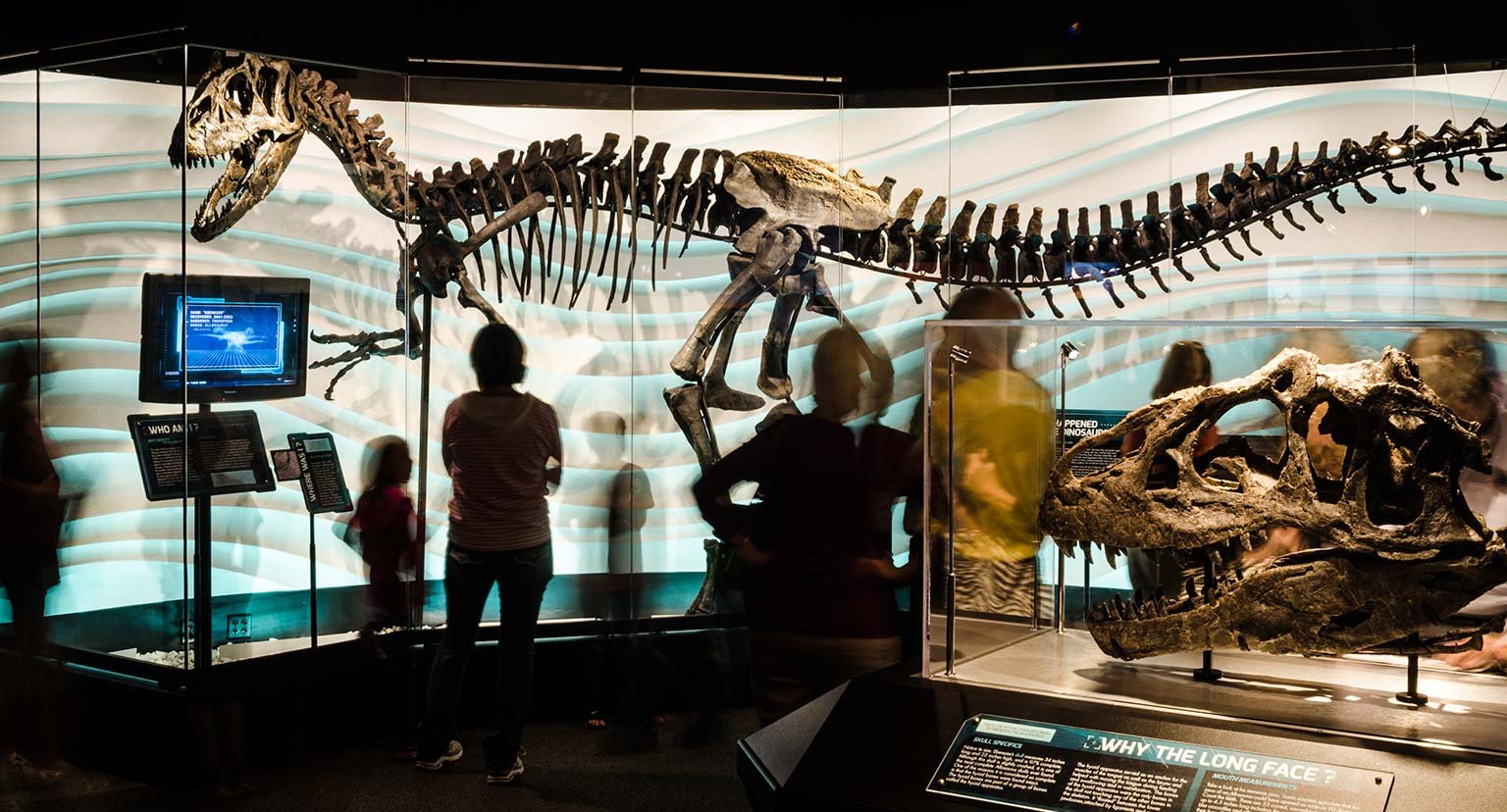
The Allosaurus on display at the Creation Museum is named Ebenezer, which means “stone of help.”
Indisputably Created by God as a Unique Kind of Creature
Bible believers should be very much at home with dinosaurs. Dinosaurs were well-designed land animals that clearly fit the description of “beasts of the earth,” which God created on Day Six of the Creation Week only about 6,000 years ago (Genesis 1:24–25). That was the same day He created Adam and Eve, the first human couple, so humans and dinosaurs definitely lived at the same time.
People today are more familiar with Tyrannosaurus rex, the “tyrant lizard king” who reached 42 feet (13 m) in length and weighed 4–6 tons (3–5 m. tons).1 Yet the somewhat smaller Allosaurus (Greek for “different” or “other lizard”) was once better known. It appeared in Sir Conan Doyle’s The Lost World (1912), long before T. rex made his appearance with Fay Wray in King Kong (1933).
Despite a few superficial similarities, like big teeth and huge size, Allosaurus is a completely different creature, likely belonging to a different created kind and uniquely designed to rule his domain (see above).
By examining the contents of the layers where Allosaurus fossils are found, we can begin to reconstruct the environment in which he lived before the Flood. Nearly all Allosaurus fossils are found in the “Jurassic” Morrison Formation, which extends from Canada to New Mexico (the only other record of Allosaurus outside the Morrison is across the Atlantic Ocean in Portugal). The Allosaurus fossils of the Morrison are not alone: their remains are found with a unique combination of plants and animals, and Allosaurus appears to have been at the top of a food chain in a completely different pre-Flood ecosystem (akin to Africa’s Serengeti Plain today) than the one where T. rex lived.2
Their fossils are never found together. T. rex is always in the same layer as Triceratops, while Allosaurus is in the same layer as Stegosaurus. In fact, paleontologists have found an Allosaurus vertebra with a hole that matches the Stegosaur’s tail spike, and they found a Stegosaurus neck bone with an Allosaurus-like bite mark. Who knows what clues we can learn from Ebenezer, once we study his bones carefully?
Allosaurus and the other creatures living in his ecosystem appear to have been buried slightly earlier than T. rex and his ecosystem during Noah’s Flood. By studying the sediments in which Ebenezer was found, we can learn more about the other creatures that got swept away with him. Dr. John Whitmore, the head of the geology department at Cedarville University, is working with the author on a study of the site where Ebenezer was found.
Catastrophically Buried in a Worldwide Flood
Creationists should be very much at home with a biblical explanation for the dinosaurs’ demise. As a result of Adam’s rebellion against his Creator, about 1,650 years later the world had become full of violence (Genesis 6:11). God decided to judge the earth by sending a global cataclysmic Flood to destroy it and all the land-dwelling, air-breathing creatures, except for those preserved on the Ark with Noah and his family (Genesis 7:11–24). So all those creatures outside the Ark, including dinosaurs, were swept away by the Flood waters and buried in many thick sand and mud layers all around the globe, where they became fossilized as the layers hardened to rocks, about 4,350 years ago.
Every fossil has its own story, and by studying each one, we can begin putting together a better picture of the whole history.
Like their evolutionary counterparts, creationists are still trying to piece together the details about the burial of each individual creature in each separate fossil layer. Every fossil has its own story, and by studying each one, we can begin putting together a better picture of the whole history.
About 40 miles (64 km) northwest of the Ebenezer dig is the famed quarry at Dinosaur National Monument (see map below). There, dinosaur bones are mostly ripped apart and separated. Other quarries contain several Allosaurus specimens buried together. But Ebenezer appears to have been alone, and his bones remained intact. Why is that? The answer to such questions can tell us more about the dark, chaotic days of the Flood, which was unlike any other period in earth history (and never to be repeated).
How did Ebenezer meet a violent death during the global cataclysmic Flood? There are at least three major clues we know so far: the local context where his bones were found, the physical contents of the Morrison Formation strata where he was buried, and the vast scale of the Morrison deposit.
Local Context of Ebenezer’s Remains
Ebenezer was found buried lying on his left side, the skeleton essentially intact with the bones still mostly laid out in the correct anatomical order (paleontologists call this an “articulated” skeleton). In other words, his carcass was essentially buried whole. This is unlike many of the other dinosaur remains in the Morrison Formation.
However, while Ebenezer’s neck vertebrae were still attached to his skull, they and the skull were broken off from the spine and buried slightly out of alignment with the rest of his body, the head at a steep downward angle. So while his carcass was buried whole, his neck must have been broken either during transport in the sediments that entombed him or in the burial process.
Yet both transport and burial had to be rapid for Ebenezer’s carcass not to have been ripped apart and his bones scattered. Only violent flash floods today occasionally transport and bury large animal carcasses before complete disarticulation.3 The rapid process often allows the soft tissues of the just-perished animal to hold the skeleton together.
Content and Vast Scale of the Morrison Formation
Ebenezer was found in a sandstone bed within the Brushy Basin Member, a subdivision of the Morrison Formation.4 As is typical of the Morrison Formation, this sandstone bed consists of mineral grains, rock fragments, and pebbles postulated—due to their shape and composition—to have come from a volcanic source that massively exploded to the west.5 In fact, it is thought the Brushy Basin Member consists almost wholly of volcanic products.6 The particles in many sandstones are usually well sorted, with clearly defined horizontal and inclined layering, known as bedding and cross-bedding respectively. But these features are virtually missing in this sandstone, and the randomness is better explained by “mass flow” processes.
Evolutionary geologists admit that catastrophic processes occurred, but they say they happened on a local scale, like flash floods today. Could that be the case? They are assuming the present is the key to the past, whereas Flood geologists insist that God’s eyewitness account in the Bible tells us about a one-time, global cataclysmic Flood that is the key to understanding these rocks and fossils.
The Morrison Formation today still covers 700,000 square miles (more than 1.8 million square km). Within it the Brushy Basin Member is 470 feet (143 m) thick. That’s taller than a 45-story building! To deposit sediments this wide and thick requires a staggering volume of volcanic materials: at least 4,300 cubic miles (more than 17,900 cubic km)! (By contrast, the Mt. St. Helens explosion in 1980 spewed only one-quarter of a cubic mile across the western United States.)
Furthermore, the Morrison Formation is only part of one of several related megasequences (packages of marine-fossil-bearing sedimentary layers) that stretch right across the North American continent.7 For rock layers to be deposited right across the continent and contain sea creatures means the ocean waters had to rise and cover the whole continent. Yet these megasequences aren’t limited to a single continent, but spread over several continents.8 These are exactly the conditions during Noah’s Flood as described in the Bible.
Conclusion
So Ebenezer met a violent death as he was swept away by the rising Flood waters moving swiftly up and across the continent’s surface. Before his carcass could rot while floating in the Flood waters and his skeleton be scattered, his body was caught in a massive debris flow full of sand and volcanic materials. Dumped with the rapidly-accumulating sediments, his neck was broken as his body was buried on its left side. Entombed, his bones were rapidly fossilized by the chemical-rich waters in the sediments.
The dinosaur Ebenezer—like all other dinosaurs—is a testament to the global Flood and the Bible’s accuracy. It is very much at home in a creationist museum, and a good friend to our cause. Once they are properly understood, dinosaurs should make evolutionists, not creationists, feel awkward.

Land of the Lost
Allosaurus fossils were discovered in 1877 among some cliffs that local Colorado miners called Garden Park. Over the next few decades, dozens of specimens turned up all over the West in the same fossil layer, which came to be known as the Morrison Formation. As the most common predator in this layer, Allosaurus captured the popular imagination—earning a lead role in The Lost World novel (1912) and silent film (1925).
Allosaurus was, indeed, a lead figure in the lost world before the Flood. The fact that all these fossils appear in the same layer indicates they once lived in the same general area, before the Flood swept them up. The biggest graveyard where their remains are found is the Cleveland-Lloyd Quarry. Since the 1930s, thousands of bones from around fifty specimens have been found there. But these bones are scattered (disarticulated). Scientists were excited to find other specimens with their bones together (articulated). “Big Al,” nearly 95% complete, was found in 1991. And creationists later discovered “Ebenezer” in 2000 (now on display at the Creation Museum).
By studying these fossils and their various burial grounds, scientists are piecing together the varied processes that buried, and sometimes reburied, these dinosaurs. Some dinosaurs were buried whole, while others decomposed before reburial. A single catastrophe is the easiest way to explain so many bones in one place like the Cleveland-Lloyd Quarry, and even some secular paleontologists admit that.
A Big, Bad Beast Like T. rex
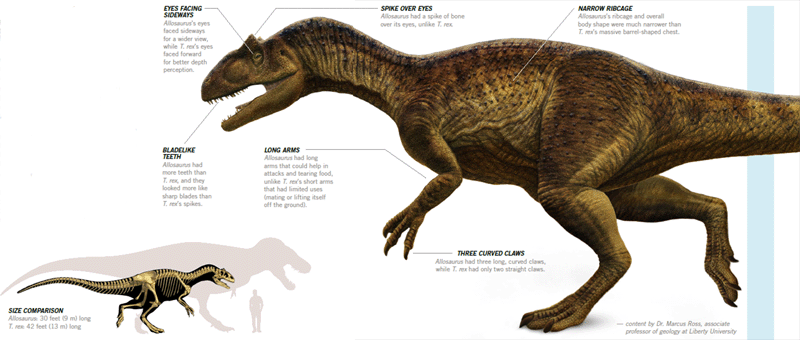
—content by Dr. Marcus Ross, associate professor of geology at Liberty University. View larger image.
If you put Allosaurus fragilis side by side with Tyrannosaurus rex, T. rex would win hands down in the size category. But does that make Allosaurus less fearsome? Hardly.
Every dinosaur we find in the fossil record is a wonder in its own right. Rather than Allosaurus being a “lesser cousin” that evolved before T. rex, we can see by their unique designs that they were each special creations.
With so many nearly complete skulls and skeletons available, creationists have looked closely at the skeletal anatomy of Allosaurus and T. rex and find strong evidence that they were members of different “kinds” (baramins) created on Day Six of Creation Week.
Some differences are obvious, such as the number of fingers. Other differences are harder to spot, but are just as certain and important. There are literally dozens of differences, some of which are listed here. The next time you’re at a natural history museum, take a closer look, discovering the unity and distinctiveness among God’s wonderful but now-extinct creations.
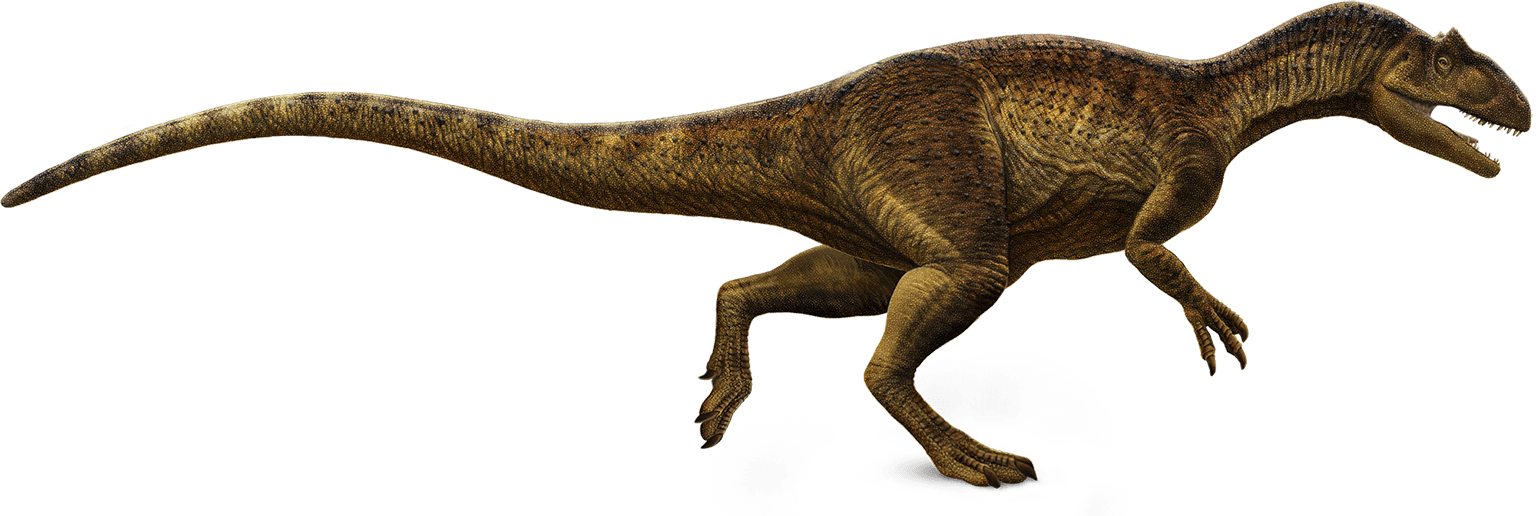
A Big, Bad Beast Like T. rex
If you put Allosaurus fragilis side by side with Tyrannosaurus rex, T. rex would win hands down in the size category. But does that make Allosaurus less fearsome? Hardly.
Every dinosaur we find in the fossil record is a wonder in its own right. Rather than Allosaurus being a “lesser cousin” that evolved before T. rex, we can see by their unique designs that they were each special creations.
With so many nearly complete skulls and skeletons available, creationists have looked closely at the skeletal anatomy of Allosaurus and T. rex and find strong evidence that they were members of different “kinds” (baramins) created on Day Six of Creation Week.
Some differences are obvious, such as the number of fingers. Other differences are harder to spot, but are just as certain and important. There are literally dozens of differences, some of which are listed here. The next time you’re at a natural history museum, take a closer look, discovering the unity and distinctiveness among God’s wonderful but now-extinct creations.

—content by Dr. Marcus Ross, associate professor of geology at Liberty University.
Answers Magazine
October – December 2014
This issue explores the marvelous human immune system. Plus take a look at the Creation Museum's new Allosaurus.
Browse IssueFootnotes
- M. Ross, “Fashioned to Be Fearless: A Closer Look at T. Rex,” Answers 6.4 (October–December 2011): 44–49.
- K. P. Wise, “Same Time, Different Place: A Closer look at Noah’s World,” Answers 6.4 (October– December 2011): 56–63.
- K. Carpenter, “History, Sedimentology, and Taphonomy of the Carnegie Quarry, Dinosaur National Monument, Utah,” Annals of Carnegie Museum 81.3 (2013): 153–232.
- J. H. Whitmore and A. A. Snelling, “Ebenezer: Taphonomic Patterns in the Morrison Formation and a Recently Collected Allosaurus from northwestern Colorado,” Journal of Creation Theology and Science Series C: Earth Sciences 4 (2014): 2–3; accessible at http://www.coresci.org/jcts/index.php/jctsc/article/view/37/58.
- W. A. Hoesch and S. A. Austin, “Dinosaur National Monument: Jurassic Park or Jurassic Jumble?” Institute for Creation Research Impact 370 (2004): i–viii.
- R. A. Cadigan, “Petrology of the Morrison Formation in the Colorado Plateau Region,” US Geological Survey Professional Paper 556 (1967): 1–113.
- A. A. Snelling, “A Complex Geologic Puzzle: A Deeper Understanding of the Flood,” Answers 9.2 (April–June 2014): 70–74.
- A. A. Snelling, “High and Dry Sea Creatures,” Answers 3.1 (January–March 2008):92–95; A. A. Snelling, “Transcontinental Rock Layers,” Answers 3.3 (July–September 2008): 80–83.
Recommended Resources

Answers in Genesis is an apologetics ministry, dedicated to helping Christians defend their faith and proclaim the good news of Jesus Christ.
- Customer Service 800.778.3390
- Available Monday–Friday | 9 AM–5 PM ET
- © 2025 Answers in Genesis


